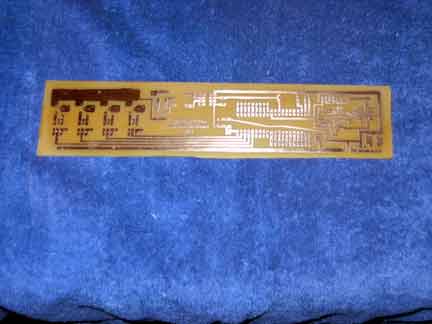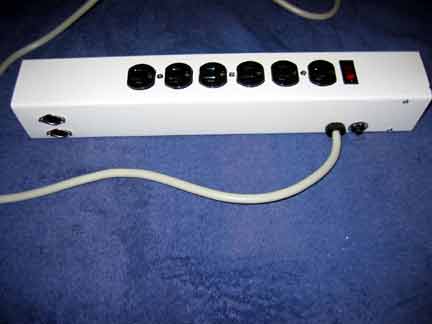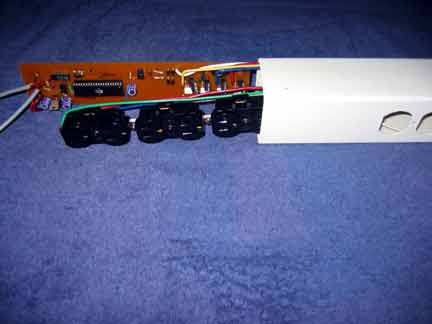 |
The Midi Controlled Light Dimmer was created to be part of an overall integrated control system for my prop building hobby. Development and refining of the dimmer pack has taken about five months, with four of these months being spent developing the firmware and learning how to program microcontrollers. This learning period was eased by the help of Wicked Beernut who helped answer several of my programing questions. Thanks again Wbn. Most of the fundamental logic of operation and circuit designs can be found in several device application notes and the Midi Standards documentation published by the American Midi Association, however I owe a bit of thanks to Ed Maste for getting me started in the right direction. |
|||||||||||||||||||||||||||||||||||||||||||||||||||||||||||||||||||||||||||||||||||||||||||||||||||||||||||||||||||||||||||||||||||||||||||||||||||||||||||||||||||||||||||||||
|
By choosing to build your own dimmer pack with the plans I have provided, please remember that you do so at your own risk and that I do not provide any warranty or accept any liability for your actions or products that you build. With that said lets move on with how I build my dimmer packs. The parts list, PCB layout, parts layout, electrical schematic, and firmware can be found at the bottom of the page. The first task after scrounging and buying the raw parts is to make the printed circuit board or PCB. If you have never done this before I would suggest that you find or make a friend who has, and ask them to help you learn this fine art. As we continue I will only be highlighting the steps involved and will assume anyone building this project has some basic understanding of how to safely build electronic devices. Additional information and detailed instruction on circuit board etching can be in these two documents Easy Printed Circuit Board Fabrication or Transferring your design to a board |
 |
|||||||||||||||||||||||||||||||||||||||||||||||||||||||||||||||||||||||||||||||||||||||||||||||||||||||||||||||||||||||||||||||||||||||||||||||||||||||||||||||||||||||||||||||
 |
Phase 1: Making the PCB Step 1: Using a laser printer, print the PCB layout onto Epson Photo Glossy Paper for Ink Jet printers Step 2: Heat transfer the printed layout to the clean copper clad board. Step 3: Soak the copper clad board and now attached paper in water for about 10 minutes. This will release the toner from the paper. Step 4: Gently remove the paper, and clean off any clay residue left from the Glossy Paper. Step 5: Dry and inspect transferred layout. Fix any problems with a good sharpie Step 6: Place Copper Clad Board in etching solution (Ferric Chloride). Pictured above Step 7: Remove board from etching solution when all excess copper has been dissolved Step 8: Wash board. First in a solution of baking soda and water (neutralizes the etching acid) and then in clean water. Step 9: Clean up your etching solution and tools Step 10: Drill the board with a #63 bit (all planned holes) Step 11: Drill the holes for the 14 gauge wire with a 1/16 inch bit Congratulation you have just made a printed circuit board. |
|||||||||||||||||||||||||||||||||||||||||||||||||||||||||||||||||||||||||||||||||||||||||||||||||||||||||||||||||||||||||||||||||||||||||||||||||||||||||||||||||||||||||||||||
|
Copper Clad board after etching |
||||||||||||||||||||||||||||||||||||||||||||||||||||||||||||||||||||||||||||||||||||||||||||||||||||||||||||||||||||||||||||||||||||||||||||||||||||||||||||||||||||||||||||||||
 |
||||||||||||||||||||||||||||||||||||||||||||||||||||||||||||||||||||||||||||||||||||||||||||||||||||||||||||||||||||||||||||||||||||||||||||||||||||||||||||||||||||||||||||||||
|
PCB after drilling
|
||||||||||||||||||||||||||||||||||||||||||||||||||||||||||||||||||||||||||||||||||||||||||||||||||||||||||||||||||||||||||||||||||||||||||||||||||||||||||||||||||||||||||||||||
|
Phase 2: Part Placement and Soldering You may find this next step easier if you use the parts placement diagram as a guide and draw the parts placement on PCB prior to starting. (As seen to the right) Step 1: Clean the copper side of the board with denatured alcohol. Step 2: Place and solder components. Start with the lowest and move towards the tallest. Step 3: Solder the wires that connect the circuit board to other areas parts of the dimmer. |
 |
|||||||||||||||||||||||||||||||||||||||||||||||||||||||||||||||||||||||||||||||||||||||||||||||||||||||||||||||||||||||||||||||||||||||||||||||||||||||||||||||||||||||||||||||
 |
 |
|||||||||||||||||||||||||||||||||||||||||||||||||||||||||||||||||||||||||||||||||||||||||||||||||||||||||||||||||||||||||||||||||||||||||||||||||||||||||||||||||||||||||||||||
|
PCB with low parts placed and soldered
|
PCB with all parts placed and soldered
|
|||||||||||||||||||||||||||||||||||||||||||||||||||||||||||||||||||||||||||||||||||||||||||||||||||||||||||||||||||||||||||||||||||||||||||||||||||||||||||||||||||||||||||||||
 |
 |
|||||||||||||||||||||||||||||||||||||||||||||||||||||||||||||||||||||||||||||||||||||||||||||||||||||||||||||||||||||||||||||||||||||||||||||||||||||||||||||||||||||||||||||||
|
PCB with wires placed and soldered. Please note and take extra time in routing the 120 volt lines.
|
The Power Strip of Parts
|
|||||||||||||||||||||||||||||||||||||||||||||||||||||||||||||||||||||||||||||||||||||||||||||||||||||||||||||||||||||||||||||||||||||||||||||||||||||||||||||||||||||||||||||||
 |
Phase 3: The Power Strip My initial thinking was to cram the dimmer PCB into a normal off the shelf power strip, creating a very clean finished package. However I was unable to find a power strip thicker then 1 1/2 inches, which leave a mere 1/4 inch of free space in the power strip squeeze the 1 inch tall PCB. Armed with the knowledge that I would need a case with at least 2 inches of clearance I continued looking for the ideal case. Yet for the price of the power strip I could not buy the needed components cheaper so I elected to continue with gutting the strip for parts. Step 1: Cut the cord flush with the strain relief Step 2: remove the four screws that hold the bottom and top of the case together (seen to the left) Step 3: Carefully gut the power strip saving all the parts Step 4: Prepare the removed parts for use in the dimmer by adding longer wires to the switch, circuit breaker, and receptacle ground. Next remove all the hot leg jumpers from the receptacle array and split one set of receptacles by cutting the hot leg jumper. The finished parts are shown below. |
|||||||||||||||||||||||||||||||||||||||||||||||||||||||||||||||||||||||||||||||||||||||||||||||||||||||||||||||||||||||||||||||||||||||||||||||||||||||||||||||||||||||||||||||
|
Above is the Inside of the power strip of parts and below is pictured all the parts from the disassembled power strip.
|
||||||||||||||||||||||||||||||||||||||||||||||||||||||||||||||||||||||||||||||||||||||||||||||||||||||||||||||||||||||||||||||||||||||||||||||||||||||||||||||||||||||||||||||||
 |
 |
|||||||||||||||||||||||||||||||||||||||||||||||||||||||||||||||||||||||||||||||||||||||||||||||||||||||||||||||||||||||||||||||||||||||||||||||||||||||||||||||||||||||||||||||
|
Phase 4: Fabricating the Case Unable to find the ideal off the shelf case I turned my attention to creating on from scratch. The base material for the case is rw-200 white PVC gutter down spout. That is essentially a 2 1/2 inch square PVC tub with a 1/16 inch wall. I have yet finalize my plans for end caps, but will probably have to cast some using quick cast.
Step 1: Cut a 17 inch piece of rw-200 PVC down spout Step 2: Center the power strip cover on the down spout so that the edge of the switch cutout is 3 inched from the end of the tub.( Shown on the left)
|
 |
|||||||||||||||||||||||||||||||||||||||||||||||||||||||||||||||||||||||||||||||||||||||||||||||||||||||||||||||||||||||||||||||||||||||||||||||||||||||||||||||||||||||||||||||
 |
Step 3: Using the strip cover as a template mark the down spout for the switch and receptacles Step 4: Cut the down spout for the switch and receptacles(shown at the left) Step 5: Drill holes for the three receptacle mounting screws Step 6: Drill holes in one side of the down spout for the din connectors (5/8 inch), circuit breaker (1/2 inch), and power cord (3/4 inch). (shown below)
|
|||||||||||||||||||||||||||||||||||||||||||||||||||||||||||||||||||||||||||||||||||||||||||||||||||||||||||||||||||||||||||||||||||||||||||||||||||||||||||||||||||||||||||||||
 |
 |
|||||||||||||||||||||||||||||||||||||||||||||||||||||||||||||||||||||||||||||||||||||||||||||||||||||||||||||||||||||||||||||||||||||||||||||||||||||||||||||||||||||||||||||||
|
Dimmer electrical connections that will have to be made inside the case
|
||||||||||||||||||||||||||||||||||||||||||||||||||||||||||||||||||||||||||||||||||||||||||||||||||||||||||||||||||||||||||||||||||||||||||||||||||||||||||||||||||||||||||||||||
 |
|
|||||||||||||||||||||||||||||||||||||||||||||||||||||||||||||||||||||||||||||||||||||||||||||||||||||||||||||||||||||||||||||||||||||||||||||||||||||||||||||||||||||||||||||||
|
Phase 5: Final assembly Step 1: Attach the four hot leads from the circuit board to the receptacles (Shown above) Step 2: Carefully slide the circuit board and receptacles into the case (shown at the right) Step 3: Secure the receptacles in the case with the three mounting screws from the power strip Step 4: Insert the switch wires through the switch hole and connect the switch hot to the circuit breaker out. (Shown below) Step 5: Install and mount the circuit breaker in the case using the locking nut from the power strip Step 6: Snap the switch into place |
 |
|||||||||||||||||||||||||||||||||||||||||||||||||||||||||||||||||||||||||||||||||||||||||||||||||||||||||||||||||||||||||||||||||||||||||||||||||||||||||||||||||||||||||||||||
 |
 |
|||||||||||||||||||||||||||||||||||||||||||||||||||||||||||||||||||||||||||||||||||||||||||||||||||||||||||||||||||||||||||||||||||||||||||||||||||||||||||||||||||||||||||||||
|
Be careful keep track of what wires are going where
|
View of inside of case prior to inserting the switch, cord, and circuit breaker
|
|||||||||||||||||||||||||||||||||||||||||||||||||||||||||||||||||||||||||||||||||||||||||||||||||||||||||||||||||||||||||||||||||||||||||||||||||||||||||||||||||||||||||||||||
 |
Step 7: Strip off about 5 inches of the power cord sheath. Step 8: Place the strain relief on the power cord (leave about 6 inches of wire for inside the case) and insert the cord into the case, snapping the relief into the case. Step 9: Connect the green ground from the power cord to the green ground from the receptacles using an orange wire nut. Push this connection into the case and out of the way. Step 10: Connect the Black hot wire from the power cord to the black hot of the circuit breaker using an orange wire nut. Push this connection into the case and out of the way. |
|||||||||||||||||||||||||||||||||||||||||||||||||||||||||||||||||||||||||||||||||||||||||||||||||||||||||||||||||||||||||||||||||||||||||||||||||||||||||||||||||||||||||||||||
|
Step 11: Connect the Black hot wire from the switch, the black hot from the circuit board, and one of the black wires from the line (110 volt) side of the transformer. Using an orange wire nut Step 12: Connect the white neutral wire from the power cord, the white neutral wire from the circuit board, the white neutral from the switch, and the other wire from the line side the transformer. Using an orange wire nut. Step 13: Connect the two yellow wires from the transformer (12.6 volts) to the low voltage power supply wires from the circuit board. Using blue wire nuts. Step 14: Cut the end off the pre-tined black center tap wire of the transformer and tape the end. Step 15: Push the wires and transformer into the end of the case. The mounting tabs of the transformer should be on the same side as the circuit breaker. |
 |
|||||||||||||||||||||||||||||||||||||||||||||||||||||||||||||||||||||||||||||||||||||||||||||||||||||||||||||||||||||||||||||||||||||||||||||||||||||||||||||||||||||||||||||||
 |
Step 16: Drill two small holes that align with the transformer mounting tabs. Note there should be about 1/2 of extra room between the transformer and the end of the tub. Step 17: Use two small screws and nuts to securely mount the transformer Step 18: Pull the wires for the midi connection through their respective holes at the other end of the case Step 19: Solder the wires to the 5 pin din connectors Step 20: Mount the din connectors in their respective holes using the four case screws from the power strip. Step 21: Attach end covers Congratulations, you have just made a Midi Controlled Light Dimmer |
|||||||||||||||||||||||||||||||||||||||||||||||||||||||||||||||||||||||||||||||||||||||||||||||||||||||||||||||||||||||||||||||||||||||||||||||||||||||||||||||||||||||||||||||
|
|
||||||||||||||||||||||||||||||||||||||||||||||||||||||||||||||||||||||||||||||||||||||||||||||||||||||||||||||||||||||||||||||||||||||||||||||||||||||||||||||||||||||||||||||||
|
||||||||||||||||||||||||||||||||||||||||||||||||||||||||||||||||||||||||||||||||||||||||||||||||||||||||||||||||||||||||||||||||||||||||||||||||||||||||||||||||||||||||||||||||

